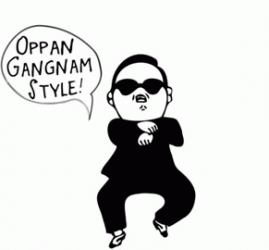In Psy’s music video, “Gentleman,” it portrays an opposite perspective of the normative ideals of a true gentleman. This music video has been a sensational hit on YouTube and has effectively displayed strong images of mockery against such gentlemen behaviour. In the music video, it has included many non-gentlemen behaviours like unstringing bikinis and pulling chairs away from women when they were about to sit. All these Psy’s pranks with women have ultimately shown us this problematic nature of this masculine identity within our modern world. Therefore, the presentation of Psy’s “Gentlemen,” can be perceived as a comic relief which incorporates dance and lyrics as a way to exhibit the treatment women being constantly sexualized and objectified in a patriarchal society like Korea.
First off, the success of his first viral hit, “Gangnam style,” has aligned many similarities with “Gentlemen,” due to the fact that it illustrates many critiques of randomness of the video. In particular, within each of these music videos, Psy includes iconic dance moves as a way to further provide entertainment and as a “sexless and clownish performer (Park 2015, 203).” In this case, in “Gentlemen,” not only did he execute many childish pranks on women, but also created a signature move with his hips swaying and his hands under his chin, that further produces Psy as an arrogant character. This results in reflecting an image of gentlemen displaying a satire way treating women today. In addition, the women in “Gentlemen,” were constantly being sexually objectified through their dances with bikini outfits and short dresses. For many instances, women were swaying their hips in bikinis like Psy while standing on top of a man laying down. As a result, this characterizes as “men [being] more powerful, dominant, aggressive, and violent, while women…to be presented as weak, dependent, submissive, and nurturing (Lin & Rudolf 2017, 30).” Certainly, the role of “costumes, [and] choreography” has provided a powerful empathises on women on “Gentlemen” being innocent and submissive within their role within the patriarchal society in Korea (Lin & Rudolf 2017, 30).
Although the majority of the lyrics in “Gentlemen” were in Korean, Psy has also ended the music video with an English chant. The exact phrases where he chants repetitively, “I’m going to make you sweat, I’m going to make you wet.” It is apparent that English mixing in lyrics was present in “Gentlemen” and has been used as a technique to “illustrate the playfulness [in] accompanying the convergence of multilingual ingredients…[to] reveal…national popular culture in general, and Korean popular music in particular (Jin & Ryoo 2014, 128).”Overall, these lyrics are constantly being repeated in Psy’s “Gentlemen,” to expose this excessive arrogance of hyper-sexualizing and illustrating obvious objection of women in the video.
All in all, the idea of women continually perceived as a sexualized object is constantly being framed in music videos like “Gentlemen.” There is no doubt that small theatrical acts like dance choreographies and even lyrics within the song that represent gender politics within our modern world. In this particular music video that Psy has created produces a mockery of real gentlemen that encourages the concept of disrespecting women in society today. As a result, “Gentlemen” presents dances and lyrics to facilitate the realignment of the role of women within the patriarchal society that Korea currently still embodies today.
– Emily Chow
Bibliography
Jin, Dal Yong, and Woongjae Ryoo. “Critical Interpretation of Hybrid K-Pop: The Global-Local Paradigm of English Mixing in Lyrics.” Popular Music and Society37, no. 2 (2012): 113-31.
Lin, Xi, and Robert Rudolf. “Does K-pop Reinforce Gender Inequalities? Empirical Evidence from a New Data Set.” Asian Women33, no. 4 (2017): 27-54.
Park, Michael K. “Psy-Zing up the Mainstreaming of “Gangnam Style”.” Journal of Communication Inquiry39, no. 3 (2015): 195-212.

